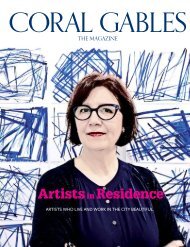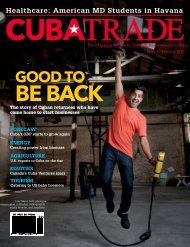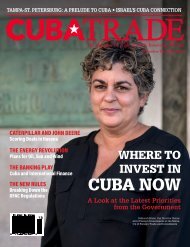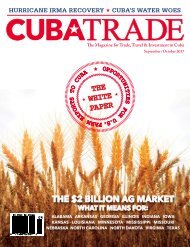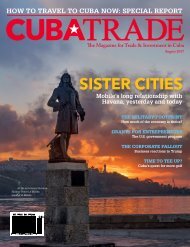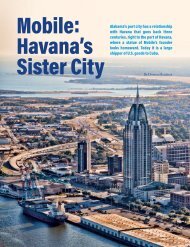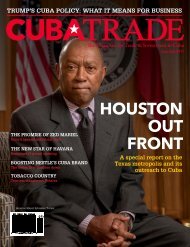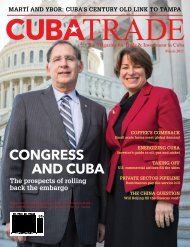CubaTrade-April2017-FLIPBOOK
You also want an ePaper? Increase the reach of your titles
YUMPU automatically turns print PDFs into web optimized ePapers that Google loves.
Holguín boasts five main plazas with traditional parks and Spanish-style churches. Students from Montreal, Dana Moshaev and Dennis Mirne Guardalavaca lifeguard Carlos Medina, proudly displays his tattoo<br />
private eateries like TripAdvisor’s top-rated 1910 Restaurante,<br />
where we dined three times for octopus and other treats. Tourism<br />
is taking off, with more hotels planned along the province’s white<br />
sand beaches including Guardalavaca.<br />
To be sure, many things remain the same. I was the first<br />
American woman that many of my new acquaintances had ever<br />
met. Most people I talked with had never been outside of Cuba,<br />
and many hadn’t even visited Havana, some 500 miles away.<br />
Holguín is still a distant province in a once-isolated nation,<br />
but it was clear as soon as I touched down at the airport that it<br />
was a long way from 1997. For starters, we flew in from Miami<br />
on American Airlines for around $200 round-trip. U.S. commercial<br />
flights to Cuba began just last year after a half-century hiatus;<br />
charters before that had often cost more than double. Holguín’s<br />
Frank Pais International Airport, named for a leader of the<br />
Cuban Revolution, used to be smaller, and I recall a mural on the<br />
airport wall of Fidel Castro and other revolucionarios with thick<br />
beards. Now, I saw only tourist posters.<br />
Our taxi driver, José Serrano, turned out to be an agricultural<br />
engineer who used to run a state enterprise overseeing hundreds<br />
of workers. He said he now earns more money working fewer<br />
hours with fewer headaches driving tourists and others in his<br />
1980s Russian car. José dropped us at one of the city’s five main<br />
plazas next to a traditional park with a Spanish-style church.<br />
We rented rooms in a 1913 house that hosted a private medical<br />
practice before the Revolution. The family, who inherited the<br />
house and now lives there, calls it Casa Don Diego to honor their<br />
young son. They’ve been renting to travelers for three years.<br />
Greeting us was friendly and efficient Sahily Fernández, the<br />
wife and mom who holds a degree in economics and worked 13<br />
years in banks. She offered us fresh guava juice as she filled out<br />
government paperwork required for rentals. Her husband, a doctor<br />
named Nestor Mendez, had spent five years in Venezuela on a<br />
medical mission that paid better salaries than those in Cuba. He<br />
saved up that money and invested it in appliances and improvements<br />
to the house. He never could have afforded the upgrades<br />
and entered the tourism sector, we found out, if he’d relied only<br />
on salaries paid in Cuba. Specialist doctors in Cuba typically earn<br />
less than $90 per month, even after recent raises.<br />
I paid 25 CUC, or about $28, per night for a clean, spacious<br />
room upstairs, with gorgeous Cuban floral tiles, a 13-foot ceiling<br />
and a view overlooking a clay-tile roof to hills in the distance. I<br />
had my own bathroom just outside in the hall. Breakfast cost less<br />
than $5 per day for a fruit plate with fresh guava, mango, banana,<br />
and pineapple, plus eggs, ham, cheese, toast and all the café con<br />
leche I could drink. In Havana, the room likely would run 30-50<br />
CUC and breakfast 5 CUC or more.<br />
To stay in touch with the United States, I bought a card<br />
from the office of state telecom company ETECSA in the city’s<br />
main plaza, and either stood or sat there to use wifi at a cost of<br />
1.50 CUC per hour. Around me, locals chatted over video-apps<br />
with family and friends overseas, and some children called out<br />
“Papi.” Wifi connections were much better than in Havana,<br />
possibly because there were fewer users at each wifi spot. Even 10<br />
years ago, the idea of public wifi would have been unthinkable.<br />
In all, more than 1 million people now live in Holguín province,<br />
including some 300,000 in the municipality that hosts the<br />
capital dubbed “the city of parks.” The place gets its name from a<br />
Spanish military officer who founded a settlement there in 1545.<br />
A world-class bronze mural spanning an entire block next to a city<br />
park depicts the area’s history, starting with the indigenous Taino<br />
Indians, the Spanish conquistadors and Holguín himself, slavery<br />
and abolition, and Cuban independence. It’s only part of the<br />
extensive street art added around the city in recent years, including<br />
clay sculptures that resemble trees and life-size bronze figures.<br />
Still, for many visitors, the real attraction isn’t the town but<br />
the province’s largely undeveloped beach. We headed out one day<br />
to Guardalavaca, a favorite among Canadians for its powdery<br />
white sand. There we met lifeguard Carlos Medina, 39, who has<br />
family in Canada and Italy, but prefers to stay in Cuba where he<br />
earns a decent living in tourism. He proudly wears a tattoo that<br />
says in English, “We may not have it all together, but together, we<br />
have it all.”<br />
Sunning on beach chairs were two college students from<br />
Montreal: Dennis Mirne, 22, and Dana Moshaev, 23, who both<br />
speak Spanish. Mirne was on his third trip to an all-inclusive<br />
resort on the beach and encouraged his friend to join. The price:<br />
About $700 each, covering round-trip airfare on Cubana Airlines<br />
from Canada and a week-long stay with food, drinks, and even<br />
alcoholic beverages. “It’s safer compared to Mexico or other places,”<br />
said the finance major, who had traveled outside the resort<br />
to hang out in a city nightclub, among other spots. “And price to<br />
quality, the value is very good.”<br />
A student of history, I couldn’t forego a visit to a Taino burial<br />
site near Guardalavaca. Excavated by a team from the University<br />
of Holguín, it’s been made into a small indigenous museum,<br />
Chorro de Maita, that also exhibits relics such as coral-bead bracelets<br />
and ceramics. Across the street there’s a somewhat touristy<br />
recreation of a Taino village, which does manage to convey the<br />
basics of life before Christopher Columbus, including the round<br />
palm-roofed huts called bohios, the hammocks used for sleeping,<br />
and the many plants used for medicine.<br />
For sunsets, we were advised to scale the Loma de la Cruz, or<br />
Hill of the Cross, for an expansive view over the city. José took<br />
us by taxi, but many locals climbed the 365-plus stairs to the top,<br />
some in exercise gear. Visitors from near and far happily snapped<br />
photos.<br />
Driving past sugarcane fields, farms, a baseball stadium, and<br />
even a hotel that boasts the renown beer-drinking donkey Pancho,<br />
you can work up an appetite in Holguín. I heartily suggest<br />
a visit to the 1910 Restaurante, run by Hugo Pupo and his wife<br />
Marisol Corpas in a family home. Pupo said few Americans<br />
come, but he welcomes them: “They tip the best.” And definitely,<br />
if you like seafood, order the octopus, grilled. H<br />
94 CUBATRADE APRIL 2017<br />
APRIL 2017 CUBATRADE<br />
95



